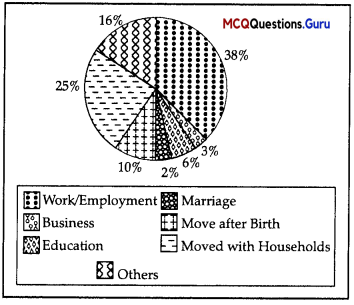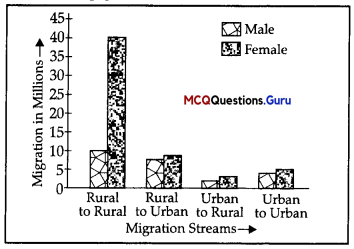The World Population: Distribution, Density and Growth Class 12 MCQs Questions with Answers
The World Population Distribution Density And Growth MCQ Question 1.
refers to the way in which the population is spaced out all over the world.
(A) Density of population
(B) Population distribution
(C) Population expansion
(D) Population explosion
Answer:
(B) Population distribution
The World Population Class 12 MCQ Chapter 2 Question 2.
What is considered as the most important factor for life?
(A) Electricity
(B) Animals
(C) Water
(D) Society
Answer:
(C) Water
![]()
Explanation:
All the living things (plants and animals) need water to live.
Class 12 Geography Chapter 2 MCQ Question 3.
The Arctic region and the Antarctica continent are situated near:
(A) The Sahara Desert
(B) The North and South Poles
(C) Amazon Basin
(D) the Equator
Answer:
(B) The North and South Poles
Explanation:
The Arctic encompasses a vast frozen ocean around the North Pole. Antarctica is a frozen continent anchored by the South Pole and surrounded by vast open oceans.
The World Population Distribution Density And Growth Class 12 MCQ Question 4.
The population of the world is:
(A) Equally distributed
(B) Sparsely distributed
(C) Unevenly distributed
(D) Haphazardly distributed
Answer:
(C) Unevenly distributed
Explanation:
Geographical, cultural, economical and social factors influence spatial distribution of population.
World Population Distribution Density And Growth MCQ Chapter 2 Question 5.
If the population decreases between two points of time, it is known as:
(A) neutral growth of population
(B) positive growth of population
(C) negative growth of population
(D) negligible growth of population
Answer:
(C) negative growth of population
![]()
Explanation:
A negative growth rate would mean a population size gets smaller, reducing 1 the number of people inhabiting that country.
World Population Class 12 MCQ Chapter 2 Question 6.
Those factors which make the place of destination seem more attractive than the place of origin are known as:
(A) push factors
(B) pull factors
(C) migration factors
(D) immigration factor
Answer:
(B) pull factors
Explanation:
Pull factors are positive aspects that attract people to move to a place e.g. good employment opportunities, better facilities, education and medical facilities.
MCQ Questions For Class 12 Geography Chapter 2 Question 7.
(Bi/P) x 1000 =
(A) Crude Birth Rate
(B) Negative Birth Rate
(C) Positive Birth Rate
(D) Zero Birth Rate
Answer:
(A) Crude Birth Rate
Explanation:
It is important to calculate crude birth rate because it is a useful indicator in studies of population around the world.
![]()
Class 12 Geography Chapter 2 The World Population MCQ Question 8.
Those factors which make the place of origin seem less attractive are known as:
(A) pull factors
(B) push factors
(C) immigration factors
(D) Economic factors
Answer:
(B) push factors
Explanation:
Freedom from political oppression, conflicts, chaos and war are some of the push factors that force people to leave their place of origin.
Geography Class 12 Chapter 2 MCQ Question 9.
World population exploded in the eighteenth century after the:
(A) World War I
(B) World War II
(C) Civil War
(D) Industrial Revolution
Answer:
(D) Industrial Revolution
Explanation:
With industrialization, if improvements in medical knowledge and public health, together with a more regular food supply, brought about a drastic reduction § in the death rate but no corresponding decline in the birth rate. The result was a population explosion.
![]()
The World Population MCQ Chapter 2 Question 10.
The growth of population is low in:
(A) developed countries
(B) third world countries
(C) developing countries
(D) Highly industrialized countries
Answer:
(A) developed countries
Explanation:
Developed countries tend to have a lower fertility rate due to lifestyle choices associated with economic affluence, leading to low growth of population.
MCQ Of The World Population Class 12 Question 11.
The consumption of resources on a faster rate is known as:
(A) development of resources
(B) depletion of resources
(C) declining of resources
(D) mis- muster of resources
Answer:
(B) depletion of resources
The World Population MCQ Class 12 Question 12.
Agrarian society depends on agriculture as the:
(A) primary means of subsistence
(B) neutral means of subsistence
(C) secondary means of subsistence
(D) None of the Above
Answer:
(A) primary means of subsistence
Explanation:
Agrarian society can be defined as a society where a majority of its population derives its income from agriculture and related activities.
![]()
Geography Chapter 2 Class 12 MCQ Question 13.
The first stage of the Demographic Transition Theory has:
(A) high fertility and low mortality
(B) high fertility and high mortality
(C) low fertility and low mortality
(D) None of the Above
Answer:
(B) high fertility and high mortality
Explanation:
During this stage, the population is stable, with both high birth rates and high death rates.
World Population MCQ Class 12 Question 14.
In the second stage of Demographic Transition Theory:
(A) fertility remains low
(B) fertility remains high
(C) fertility remains stagnant
(D) Fertility plays no major role
Answer:
(A) fertility remains low
Explanation:
The total population of a country in Second stage rises because births outnumber deaths.
Chapter 2 Geography Class 12 MCQ Question 15.
Spacing or preventing the birth of children is known as:
(A) home planning
(B) office planning
(C) family planning
(D) family prevention
Answer:
(C) family planning
![]()
The World Population Distribution Density And Growth MCQs Question 16.
Which continent has population?
(A) America
(B) Africa
(C) Australia
(d) Asia
Answer:
(B) Africa
Explanation: Africa has the highest growth rate g of population due to several factors, including the rising life expectancy and the high fertility rates registered on the continent.
Geography Chapter 2 MCQ Class 12 Question 17.
Which country in the world has the lowest growth rate of population ?
(A) Lebnon
(B) Iraq
(C) Iran
(D) Syria
Answer:
(D) Syria
Explanation:
Due to the Syrian Civil Wap the Syrian population decreased.
Question 18.
Arrange the countries in ascending order of their population:
(i) China
(ii) USA
(iii) India
(iv) Indonesia
(A) (i),(ii),(iii),(iv)
(B) (iv),(ii),(iii),(i)
(C) (iii),(iv),(i),(ii)
(D) (iv),(iii),(ii),(i)
Answer:
(B) (iv),(ii),(iii),(i)
Explanation:
The presence of industries, various social facilities, improved infrastructure and high fertility rate makes China the most populous country in the world.
Question 19.
How is density of population of a region calculated ?
(A) Density of Population = Population/Area
(B) Density of Population = Population of the country
(C) Density of Population = Decreasing population
(D) None of the Above
Answer:
(A) Density of Population = Population/Area
![]()
Question 20.
The change in number of inhabitants of a territory during a specific period of time is known as :
(A) positive growth rate
(B) negative growth rate
(C) population growth
(D) density of population growth
Answer:
(C) population growth
Explanation:
Population growth is the increase in the number of people in a population.
Question 21.
Birth rate, death rate and migration are components of:
(A) population change
(B) population unrest
(C) population ration
(D) population control
Answer:
(A) population change
Explanation:
Population change is simply the change in the number of people in a specified area during a specific time period. It is based on three fundamental
factors: birth rate, death rate, immigration.
Question 22.
The movement of people from one place to another within the country or to a foreign country is termed as:
(A) population movement
(B) population disturbance
(C) migration
(D) immigration
Answer:
(C) migration
Explanation:
Migration is the permanent change of residence by an individual or group.
![]()
Question 23.
When the birth rate is more than the death rate between two points of time it is known as:
(A) negative growth rate
(B) positive growth rate
(C) change in population graph
(D) None of the Above
Answer:
(B) positive growth rate
Explanation:
When the population growth rate is positive, per capita income growth is positive it is known as positive growth rate.
Question 24.
The expanding world trade during the sixteenth and seventeenth century, set the stage for:
(A) Outbreak of pandemic
(B) rapid population growth
(C) drastic drop on population growth
(D) unrest all across the globe
Answer:
(B) rapid population growth
Explanation:
Trade liberaliza tion and expansion generated the income effect that increased the population growth.
![]()
Question 25.
Which of the following factor helped in the reduction of birth rate and provided a stage for accelerated population growth? 0
(A) Technological advancement
(B) Conflicts and wars
(C) emergence of world power
(D) Introduction of birth control policies
Answer:
(A) Technological advancement
Explanation: Technological advances helped in lowering the fertility by stimulating the growth of the marginal cost of children and reducing the marginal benefit of children, while changing the reproductive attitude from favouring a greater number of children to favouring a lower number of children.
Question 26.
The population of non- industrial countries are normally:
(A) high
(B) low
(C) stable
(D) None of the Above
Answer:
(C) stable
Explanation:
The populations of nonindustrial countries are normally stable (and low) because high birth rates are matched by high death rates.
Question 27.
Since doubling time is based on a population’s ,………….. it can also vary over time.
(A) annual growth rate
(B) annual death rate
(C) outbreak of catastrophe
(D) government’s policies
Answer:
(A) annual growth rate
Explanation:
Growth rate is the increasing rate of the number of people in a population and doubling time is the amount of time it takes for a quantity to double in size or value. Thus, the relationship is that doubling time depends on growth rate.
Question 28.
The effect of overpopulation can be:
(A) Increase in economic development
(B) Increase in demands of basic amenities
(C) Better education facilities
(D) More help from the government
Answer:
(B) Increase in demands of basic amenities
Explanation:
Overpopulation will cause additional strains on resources. More people means an increased demand for food, water, housing and other resources.
![]()
Question 29.
Arrange the four stages of demographic transition in the correct order:
(i) Pre- industrial stage
(ii) Urbanizing/industrializing
(iii) Mature industrial
(iv) Post-industrial
OPTIONS:
(A) (i),(ii),(iii),(iv)
(B) (iv),(ii),(iii),(i)
(C) (iii),(iv),(i),(ii)
(D) (ii),(i),(iii),(iv)
Answer:
(A) (i),(ii),(iii),(iv)
Question 30.
The evolution of the population profile of a country, region or other defined geographical area over time is known as :
(A) demographic cycle
(B) demographic evolution
(C) demographic digression
(D) none of the Above
Answer:
(A) demographic cycle
Explanation:
The demographic cycle is one of the most important factors for predicting economic prosperity and performance of a country.
Question 31.
As per 2019, Life expectancy in Japan was the highest with close to:
(A) 65 years
(B) 75 years
(C) 85years
(D) 95 years
Answer:
(C) 85vears
![]()
Question 32.
Which country has the highest mortality rate as per 2019? R
(A) LTkraine
(B) Bulgaria
(C) Romania
(D) Croatia
Answer:
(B) Bulgaria
Explanation:
The mortality rate in Bulgaria is high due to diseases of the cardiovascular system, non- infectious and cancer diseases.
Question 33.
Which one of the following is not a fact?
(A) Human population increased more than ten times during the past 5(10 years.
(B) It took 1 years for the population to rise from 5 billion to 6 billion
(C) Population growth is high in the first stage of demographic transition.
(D) Population growth is high in developing nations.
Answer:
(C) Population growth is high in the first stage of demographic transition.
Explanation:
During the first stage the population is stable, with both high birth rates and high death rates, The death rates are high
because there is increased disease, minimal medical care, poor sanitation, and limited food supplies.
Assertion and Reason Based MCQs
Directions: In the following questions, A statement of Assertion (A) is followed by a statement of Reason (R). Mark the correct choice as:
(A) Both A and R are true and R is the correct explanation of A.
(B) Both A and R are true but R is NOT the correct explanation of A.
(C) A is true but R is false.
(D) A is false and R is true.
Question 1.
Assertion (A): The people of a country are its real wealth.
Reason (R): Itis they, who are the actual resources and make use of the country’s other resources and decide its policies.
Answer:
(A) Both A and R are true and R is the correct explanation of A.
Explanation:
Ultimately a country is known by 1 the people living over there.
![]()
Question 2.
Assertion (A): The population of the world is unevenly distributed.
Reason (R): Asia has many places where people are few and few place where people are very many.
Answer:
(B) Both A and R are true but R is NOT the correct explanation of A.
Explanation:
Geographical, cultural, economical and social factors influence spatial distribution of population. Since these factors vary across our planet, we have an uneven distribution of population in the world. Geographical factors like soil, climate, topography, water influence the population of an area.
Question 3.
Assertion (A): Each unit of land has limited capacity to support people living on it.
Reason (R): It is necessary to understand the ratio between the numbers of people to the size of land.
Answer:
(A) Both A and R are true and R is the correct explanation of A.
Explanation: The ways in which people have organized themselves in space at any given time represent the sum of all of the advances they have made to their overall geographical area.
Question 4.
Assertion (A): Death rate plays an active role in population change.
Reason (R): Population growth occurs not only by increasing births rate but also due to decreasing death rate.
Answer:
(A) Both A and R are true and R is the correct explanation of A.
Explanation:
The population of the world or 1 I the particular place does not remain the same. Death decreases the population.
Question 5.
Assertion (A): The 10 most populous countries of the world contribute about 60 per cent of the world’s population.
Reason (R): Out of these 10 countries, 6 are located in Asia.
Answer:
(B) Both A and R are true but R is NOT the correct explanation of A.
![]()
Explanation:
The 10 most populous countries of the world contribute about 60 per cent of the world’s population as they are rich in natural resources, have fertile soil, accessible land and favourable climate.
Question 6.
Assertion (A): Each unit of land has limited capacity to support people living on it.
Reason (R): Hence, it is necessary to understand the ratio between the numbers of people to the size of land.
Answer:
(B) Both A and R are true but R is NOT the correct explanation of A.
Explanation:
Each unit of land has limited j capacity to support people living on it because j water, food, shelter and resources in each unit a limited.
Question 7.
Assertion (A): People prefer living on flat plains and gentle slopes.
Reason (R): This is because such areas are favourable for the production of crops and to build roads and industries.
Answer:
(A) Both A and R are true and R is the correct explanation of A.
Explanation:
This is because plains are favourable for growing crops, setting up industries and for developing the transport system.
Question 8.
Assertion (A): The mountainous and hilly areas hinder the development of transport network and hence initially do not favour agricultural and industrial development.
Reason (R): So, these areas tend to be highly populated.
Answer:
(C) A is true but R is false.
Explanation:
The steep topography makes it difficult and expensive to build houses, establish factories, build roads and grow vegetation. The low temperatures also make it difficult for many to live there.
Question 9.
Assertion (A): Mediterranean regions were inhabited from early periods in history
Reason (R): This is due to their pleasant climate.
Answer:
(A) Both A and R are true and R is the correct explanation of A.
Explanation:
Mediterranean regions were inhabited from early periods in history due to their pleasant climate, fertile soil and privileged geographical location of the Mediterranean area between 3 continents helped it flourish.
Question 10.
Assertion (A): Areas with mineral deposits attract industries.
Reason (R): Mining and industrial activities generate employment.
Answer:
(B) Both A and R are true but R is NOT the correct explanation of A.
Explanation:
Areas with mineral deposits play a major role in the industrial growth of a nation and its people at large. It generates revenue, encourages development and employees a large number of people.
![]()
Question 11.
Assertion (A): Cities offer better employment opportunities, educational and medical facilities, better means of transport and communication.
Reason (R): It leads to rural torural migration and cities grow in size.
Answer:
(C) A is true but R is false.
Explanation:
Decline in income from agriculture, lack of alternative job, declining j local economy, and denied access to basic facilities leads to rural to urban migration and cities grow in size.
Question 12.
Assertion (A): The Kobe-Osaka region of Japan is thickly populated
Reason (R): This is because of the presence of a number of industries.
Answer:
(A) Both A and R are true and R is the correct explanation of A.
Explanation:
The Kobe-Osaka region of Japan is thickly populated because of the presence of a number of industries like:- electronics, pharmaceutical, machinery, device, chemical, food, and construction industries. It is the second most populated region in Japan.
Question 13.
Assertion (A): Some places attract more people because they have religious or cultural significance.
Reason (R): In the same way – people tend to move away from places where there is social and political unrest.
Answer:
(B) Both A and R are true but R is NOT the correct explanation of A.
Explanation:
People may choose to move for a variety of reasons, such as employment opportunities, to escape a violent conflict, environmental factors, educational purposes, or to reunite with family. Others feel they must leave because of poverty, political unrest, gang violence and the discrimination they face in daily life.
![]()
Question 14.
Assertion (A): Death rate plays an active role in population change.
Reason (R): Population growth occurs not only by increasing births rate but also due to decreasing death rate.
Answer:
(B) Both A and R are true but R is NOT the correct explanation of A.
Explanation:
Natural decrease occurs when death rate is greater than birth rate.
Question 15.
Assertion (A): When people move from one place to another, the place they move from is called the Place of Origin.
Reason (R): The place of origin shows a decrease in population while the population increases in the place of destination.
Answer:
(B) Both A and R are true but R is NOT the correct explanation of A.
Explanation:
Economic, political, cultural, or environmental reasons force people to move away from the place of origin.
Question 16.
Assertion (A): A small increase in population is desirable in a growing economy.
Reason (R): However, population growth beyond a certain level creates no problems.
Answer:
(C) A is true but R is false.
Explanation:
Higher population growth rates would clearly lead to higher economic growth rates.
Case-Based MCQs
I. Read the case study given below and answer the questions that follow:
The people of a country are its real wealth. It is they who make use of the country’s resources and decide its policies. Ultimately a country is known by its people. It is important to know how many women and men a country has, how many children are born each year, how many people die and how? Whether they live in cities or villages, can they read or write and what work do they do? The world at the beginning of 21st century recorded the presence of over 6 billion population. The population of the world is unevenly distributed. The remark of George B. Gressey about the population of Asia that “Asia has many places where people are few and few places where people are very many” is true about the pattern of population distribution of the world also.
Question 1.
What is the real wealth of a country?
(A) Government
(B) People
(C) Educational institutes
(D) Economy
Answer:
(B) People
Question 2.
Why is it important to know how many women and men a country has, how many children are born each year, how many people die?
(A) For planning purpose
(B) For push factors
(C) For pull factors
(D) For preparing military strength
Answer:
(A) For planning purpose
Explanation:
Population data helps to plan how many schools, clinics, hospitals and jobs a country needs.
![]()
Question 3.
The knowledge of how many women and men a country has, how many children are born each year, how many people die and how is known as:
(A) Density data
(B) Population data
(C) Sensex data
(D) None of the above
Answer:
(B) Population data
Explanation:
Population data can be used for planning purposes.
Question 4.
The world at the beginning of 21st century recorded the presence of over …………….. population.
(A) 6 billion
(B) 8 billion
(C) 10 million
(D) 6 million
Answer:
(A) 6 billion
II. Read the case study given below and answer the questions that follow:
There are three components of population change – births, deaths and migration. Death rate plays an active role in population change. Population growth occurs not only by increasing births rate but also due to decreasing death rate. Crude Death Rate (CDR) is a simple method of measuring mortality of any area. CDR is expressed in terms of number of deaths in a particular year per thousand of population in a particular region. By and large mortality rates are affected by the region’s demographic structure, social advancement and levels of its economic development.
Question 1.
Name the three components of population change.
(A) Migration, economy, education
(B) Migration, birth rate, death rate
(C) Migration, industries, agriculture
(D) None of the Above
Answer:
(B) Migration, birth rate, death rate
Explanation:
The difference between live births and deaths and the difference between the number of people moving into an area and the number of people moving out defines the population change.
Question 2.
……………. plays an active role in population change.
(A) Birth rate
(B) Death rate
(C) Accidents
(D) Immigration
Answer:
(B) Death rate
![]()
Explanation:
Natural decrease in population occurs when death rate is greater than birth rate. Natural increase in population occurs when the death rate is low
Question 3.
Which method is used for measuring the mortality of an area?
(A) Crude Birth Rate
(B) Crude Death Rate
(C) Population Index
(D) None of the above
Answer:
(B) Crude Death Rate
Explanation:
The crude death rate is the number of deaths per 1000 people in a year in relation to the total population. It is a simple method to measure the death rate because it j takes only the data of total mid-year population f and total deaths.
Question 4.
Name two factors that affect the mortality rate.
(A) Economic development, death rate
(B) Demographic structure, economic growth
(C) Social advancement, birth rate
(D) Social advancement, demographic structure
Answer:
(D) Social advancement, demographic structure
III. Read the case study given below and answer the questions that follow:
A small increase in population is desirable in a growing economy. However, population growth beyond a certain level leads to problems. Of these the depletion of resources is the most serious. Population decline is also a matter of concern. It indicates that resources that had supported a population earlier are now insufficient to maintain the population. The deadly HIV/ AIDS epidemics in Africa and some parts of the Commonwealth of Independent States (CIS) and Asia have pushed up death rates and reduced average life expectancy. This has slowed down population growth.
Question 1.
What is the correlation between population economy?
(A) High population growth leads to high economic growth
(B) High population growth leads to limited economic growth
(C) Less population growth leads to exponential economic growth (D) None of the Above
Answer:
(B) High population growth leads to limited economic growth
Explanation:
The quantity, quality, structure, distribution, and movement of a population can help or hinder the rate of economic development.
Question 2.
Population decline is a matter of …………..
(A) happiness
(B) concern
(C) economic growth
(D) push factors
Answer:
(B) concern
Explanation:
Declining population means slower economic growth.
![]()
Question 3.
……………. is an estimate of the average number of additional years that a person of a given age can expect to live.
(A) Average life span
(B) Average death span
(C) Average life expectancy
(D) Average death expectancy
Answer:
(C) Average life expectancy
Question 4.
The increase in the number of individuals in a population is known as:
(A) Population growth
(B) Population stability
(C) Population blast
(D) None of the Above
Answer:
(A) Population growth
Explanation:
Population growth depends on 1 the rate of natural increase, or the fertility rate 1 minus the mortality rate, and net migration.
IV. Study the given graph carefully and answer the following questions :
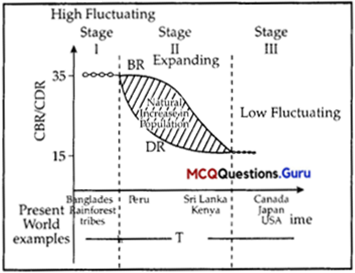
Question 1.
How does the natural increase in population occur, as per the graph?
(A) Birth Rate – Death Rate
(B) Death Rate + Birth Rate
(C) Growth Rate – Birth Rate
(D) Birth Rate + Migration
Answer:
(B) Death Rate + Birth Rate
Explanation:
The difference between the birth rate and the death rate of a country or place is causes the natural increase.
Question 2.
What does the transition from high fluctuating stage to low fluctuating stage indicate?
(A) Shift from Urban Industrial economy to Rural Agrarian economy
(B) Shift from Rural Agrarian economy to Urban Industrial economy
(C) Low Birth and Death Rate to High Birth and Death Rate
(D) Migration from Urban to Rural areas
Answer:
(B) Shift from Rural Agrarian economy to Urban Industrial economy
![]()
Question 3.
From the given graph, what condition can you infer about the developing countries?
(A) High Birth Rate and High Death Rate
(B) Low Birth rate and Low Death rate
(C) High Birth Rate and Low Birth Rate
(D) Low Birth Rate and High Death Rate
Answer:
(C) High Birth Rate and Low Birth Rate
Explanation:
The social structure, religious beliefs, economic prosperity and urbanisation within each country leads to high birth rates and low birth rates in developing countries.
Question 4.
In which stage of Demographic Transition, population explosion took place :
(A) Stage I
(B) Stage II
(C) Stage III
(D) Post Stage III
Answer:
(B) Stage II
Explanation:
Stage II is characterized by a rapid decrease in a country’s death rate while the birth rate remains high. The fall in the death rate is due to drastic improvement in the medical facilities, vaccinations, etc.
V. Study the given graph carefully and answer the following questions :
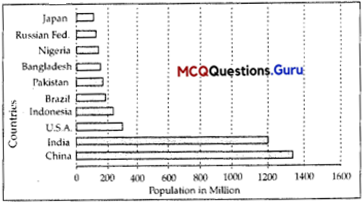
Question 1.
Identify the Asian country with the maximum population.
(A) India
(B) China
(C) Pakistan
(D) USA
Answer:
(B) China
Explanation:
The rise of industry and large scale agriculture and many other factors has lead China to have maximum population.
Question 2.
Why is Japan’s population decreasing?
(A) No pull factors
(B) Terrorism
(C) Government policies
(D) Low fertility rate
Answer:
(D) Low fertility rate
Explanation:
Japan’s overall population is shrinking due to low fertility rates and the aging population is rapidly increasing.
![]()
Question 3.
Why is Brazil sparsely populated?
(A) Due to climate
(B) Due to drug mafia
(C) Due to less land availability
(D) None of the Above
Answer:
(A) Due to climate
Explanation:
Brazil is very sparsely populated due to the climate of the area. The country suffers from frequent droughts.
Question 4.
Why is Asia the most populous continent?
(A) No contact with Western world
(B) Dictatorship
(C) No emigration allowed
(D) Rich in natural resources
Answer:
(D) Rich in natural resources .
Explanation:
Asia is rich in natural resources such as petroleum, forests, fish, water, rice, copper and silver.
VI. Study the given graph carefully and answer the following Questions:
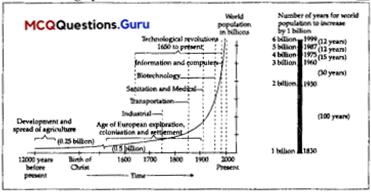
Question 1.
Which of these periods closely represents the European explorations?
(A) 1 CE to 1600 CE
(B) 1500 CE to 1700 CE
(C) 1520 CE to 1900 CE
(D) 1650 CE to 1950 CE
Answer:
(C) 1520 CE to 1900 CE
Question 2.
In how many years did world population increase from 4 billion to 5 billion?
(A) 12 years
(B) 15 years
(C) 30 years
(D) 100 years
Answer:
(A) 12 years
Explanation:
The world population increased due to better nutrition, higher birth rates, and lower mortality.
![]()
Question 3.
What is the speciality of the period 1650 CE to present?
(A) Development and spread of agriculture
(B) Colonialization
(C) Technological revolutions
(D) Transportation
Answer:
(C) Technological revolutions
Question 4.
What was the approximate population of the world in 1600s?
(A) 0.25 billion
(B) 0.5 billion
(C) 0.75 billion
(D) 1 billion
Answer:
(B) 0.5 billion
Explanation:
New crops that had come from the Americas to Asia and Europe during the 16th century contributed to population growth on these continents. The indigenous populations of the Americas, however, were decimated by diseases brought by European colonizers.
